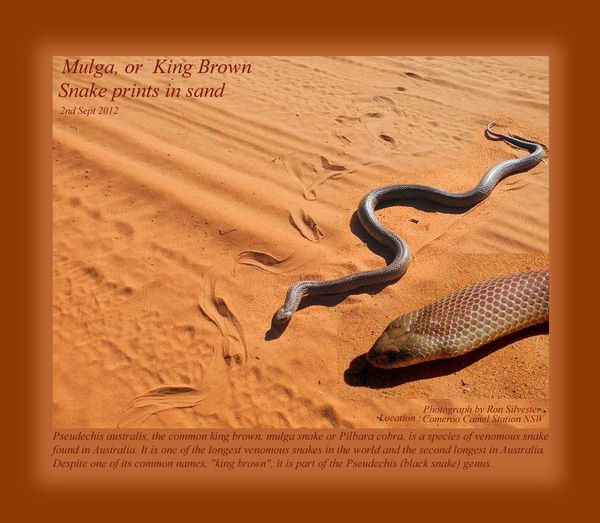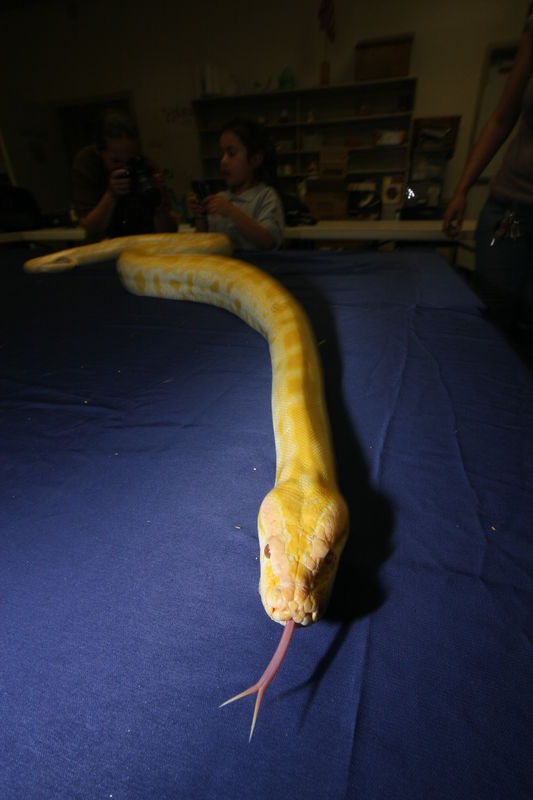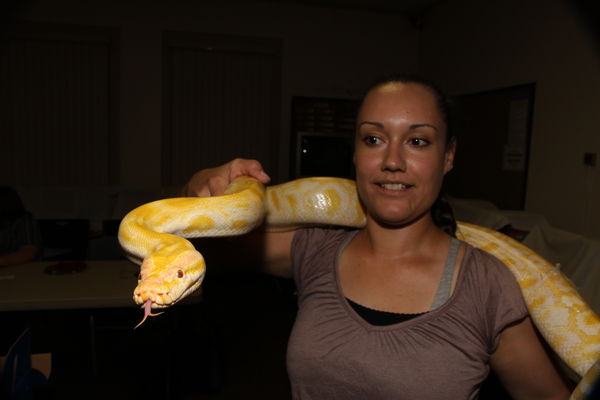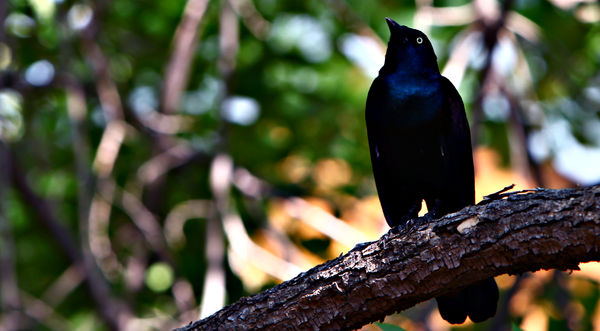How to get good pic's of a snake
Sep 26, 2012 09:33:51 #
Boa constrictors typically are not quick snakes, so sudden movement is not a serious problem. However, you should know that the scales of a snake can change color or lose their contrasting color combinations or shimmer when a flash is used since the scales reflect only certain wavelengths of light. I would seriously suggest you use continuous auxiliary lighting that does not flash when you snap your photos. This way there will be no change in color of the snake. The same problem occurs when you try to shoot photos of the new camelian paints used on automobiles. They may have numerous colors showing that can accent the curves and shape of the vehicle, but all those colors disappear when a flash is used and only a single shade shows up on the photo. Just saying.....
Sep 26, 2012 09:42:54 #
Using a flashlight like that is sometimes called "light painting".
Janem wrote:
What is a daylight torch, a flashlight? I could go to a dark room and see what I get? Love your pictures, I'll have to try it with some of my flowers. Flower pictures are my favorite, they don't mind if I take too long and most of the time the hold still. :)
Sep 26, 2012 09:55:39 #
usually they will. Unless you are moving to close and they are ready to strike. :)
Sep 26, 2012 10:00:39 #
Sep 26, 2012 10:22:22 #
Janem wrote:
What is a daylight torch, a flashlight? I could go to a dark room and see what I get? Love your pictures, I'll have to try it with some of my flowers. Flower pictures are my favorite, they don't mind if I take too long and most of the time the hold still. :)
In most parts of the world, except the USA, the thing we call a flashlight is called a "torch" or "pocket torch". And really, this makes more sense in the description since the "flashlight" doesn't really FLASH!! At least not unless we keep clicking it on and off!!
Sep 26, 2012 10:27:03 #
Flashlight at least tells you its a light but when a biscuit is called a scone, a lolly is candy and candy is also chocolate I really get confused.
Sep 26, 2012 10:29:12 #
Janem wrote:
Hi, I have only ask a question once, but I read your form often. Here is my new question. My grandson has a Brazilian Rainbow Boa and it's body has an iridescent film to it that has a rainbow glow. It sounds like it could be an awesome picture, but I have no idea how to get that iridescent color to show up. I have a Canon EOS T3i and a Canon Speedlite 430EX. Anyone have any ideas?
Thanks
Jane
Thanks
Jane
From rts2568
Hi
Snake Charmer, a python give you more time to compose, especially when used to humans around. I've sttached a shot I too recently and you will see the direction of the light. This was not idealbut because of the temperature at the time, this Mulga was wide awake, very energetic and warily skittish. Soon after a few shots while trying to discourage it from slithering off into the bush by standing in front of it, it dcided I wasn't a threat and slithered off into the bush, rasther closer than for me was comfortable, especially as I was over a hundred kilometers from any sort of medical support.
As you can see, the lighting from the sun was not the best and like flash, too glary. The best will be flash with something like a soft box, bracket your exposures, low ISO but fast shutter speed with a good depth of field. A hanky over the flash head would be a good start. Preferably have someone hold the flash remote from the camera, lighting from the front of the snake while being generous with lighting the side facing you.
Ensure a moderately neutral background, just sufficient depth of field to keep the detail of the snake in focus while ensuring the background is out of focus. Frame the head and body in camera as much as possible and or take several shots.
Experiment of course, this will force you to think about what you are doing and help to improve your self motivation.
Go capture the image.
rts2568
Snake in the wild

Sep 26, 2012 10:46:06 #
first of all,95% of all snakes are not dangerous. I would think natural light would work but you have to see the colors through the viewfinder.
Sep 26, 2012 10:52:52 #
Jer wrote:
first of all,95% of all snakes are not dangerous. I would think natural light would work but you have to see the colors through the viewfinder.
Agree. Seems to be some reactions based on fear.
Sep 26, 2012 10:55:05 #
digicamking
Loc: Raleigh, NC
Janem wrote:
Hi, I have only ask a question once, but I read your form often. Here is my new question. My grandson has a Brazilian Rainbow Boa and it's body has an iridescent film to it that has a rainbow glow. It sounds like it could be an awesome picture, but I have no idea how to get that iridescent color to show up. I have a Canon EOS T3i and a Canon Speedlite 430EX. Anyone have any ideas?
Thanks
Jane
Thanks
Jane
Use a high shutter speed as you are running away!
Sep 26, 2012 10:56:38 #
I teach a photo class and have a lady bring in several snakes in for a photo shoot. We get lots of good photos by using your flash indoors and balancing the flash with the ambient light. This will keep your colors of the snake true and bright. Some of the better shots have been during feeding time, but you got to be fast! A snake having a meal may not be for everyone, but it does get you interesting subject matter.



Sep 26, 2012 10:57:26 #
I like that digicamaking but we have to remember that the snake in question is a little boy's pet :shock:
Sep 26, 2012 10:59:14 #
Janem wrote:
Ohhh..great idea! Thanks!!
NOT A GOOD IDEA. !!!
I would suggest that this doesn't have to be approached as a work of art but rather an attempt to capture a very illusive reflection on a stinkin' snake. Fotkaman, obviously a person who delights in irritating people, as absolutely repulsive as his avatar is, got part of it right - walk around the snake and see where the effect is most noticeable, and take several shots of it bracketing for different light effects. Consider a close up of a section using your 'daylight torch' (quartz or led flashlight) LOL! and shooting a small segment where the effect is most pronounced. An overall shot and some close up sections, maybe the head.
NO POLARIZER. A polarizer's purpose is to eliminate reflections - it will cause the effect to disappear rather than heighten it. The first and most brilliant rainbow I ever shot, taught me that lesson. One of the reasons it's hard to catch a reflection such as this or a rainbow is because the multi-coating on your lens that is there to reduce flare and reflection robs the effect of it's brilliance as it comes through the coating. Flare was a real big problem with uncoated lens and now it's fixed but at the expense of our ability to catch such reflections as this in all their glory. If, after you've tried this, since the snake isn't going anywhere, then I would resort to HDR.
You're shooting Canon. In the latest release of Canon's software RAW processing program 'Digital Photo Professional,' (DPP) Canon has (have, for the Brits, Kiwis, and Aussies ;) ), included under the 'Tools' menu selection, a very efficient HDR processor that gives you about all of what you need to process your HDR images to achieve about any effect you choose. I would suggest you go to Canon and download the updates to the software there, especially DPP and install it. If you haven't installed the CD that came with your camera, you will need to do that first or at least have the CD in your CD/DVD drive when installing the update: Down the page, under 'Drivers and Software,' select your operating system and version here: http://www.usa.canon.com/cusa/consumer/products/cameras/slr_cameras/eos_rebel_t3i_18_55mm_is_ii_kit#DriversAndSoftware - then download what you need for HDR if you get that far. Canon's software is quite good and powerful if you bother to learn it. About the only thing you might need anything else for is 'layers' if you get to that point. DPP allows you to do your HDR on your RAW files as opposed to tiff or jpg. It's an advantage you will come to appreciate as you become more familiar with RAW v. jpg.
I have just had a bout with some iridescent reflections on some Grackles with less than stellar results and I've attached a couple of examples below:


Sep 26, 2012 11:00:15 #
Sep 26, 2012 11:05:32 #
So you say has when we say have. Isn't has past tense and have present tense. You say tomatoes and we say potatoes :-)
I like your bird photos. What kind of bird is that?
I like your bird photos. What kind of bird is that?
If you want to reply, then register here. Registration is free and your account is created instantly, so you can post right away.





